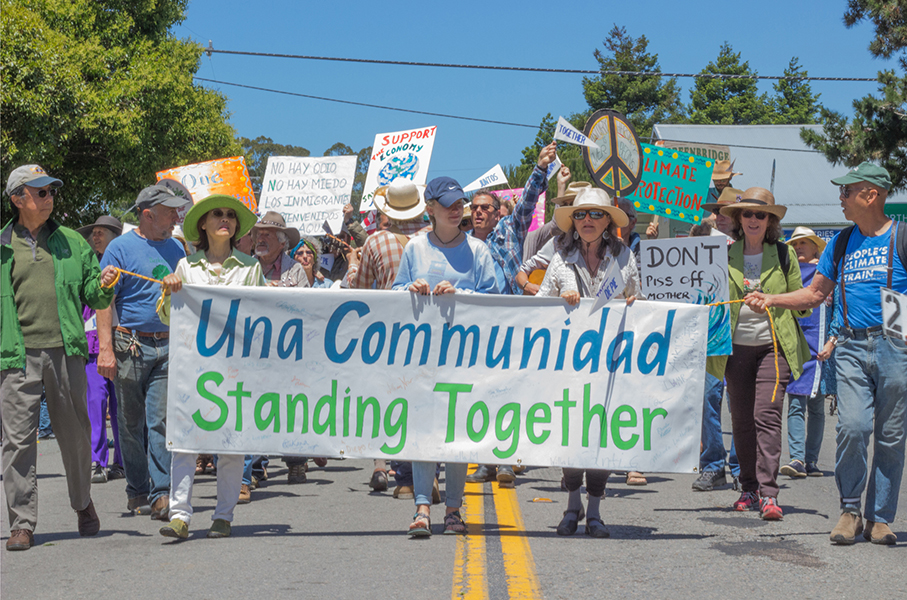Latino Photography Project
The Latino Photography Project, launched in 2003, was an answer to the gallery’s question: How do we engage creatively with the twenty per cent of the West Marin population who are Latino? We began with a photography/literacy class taught by Luz Elena Castro which led to yearly exhibitions around a documentary theme. Over the following years, the class has taken on the issues of the immigrant experience, Main Street, housing, sustainability, bridge-building, food and culture and the environment. Student photographs appear regularly in the local paper, and smaller selections of photos travel to numerous other sites and satellite shows throughout the county.
To see more work by each photographer, visit our Gallery of Latino Photography Students.
Bridging the Cultural Divide
Many of the themes involved bridging the cultural divide — showing the ethnic and socio-economic make-up of Main Street, visiting homes of both Anglo and Latino people to learn about housing problems, gardening, herbal cures, habitat restoration, or recipes from our grandmothers. Through such meetings, and the resulting photos and text, Latino and Anglo people have come to know one another and to see commonalities.
In 2008, with “La Vida: Trabajo y Familia” (“The Life: Work and Family”), the group focused exclusively on Latino life that is largely hidden from view out on the dairy ranches and in the cheese factories.

Immigrant Experience
Returning to this theme, we are able to gather from the other years’ work and expand upon a portrait of the immigrant experience from the agrarian Mexican provinces of Jalisco, Michoacan, and Oaxaca to the ranches of West Marin at the turn of this century. In bi-lingual texts, each photographer tells about the work, the 60 or 70 hour weeks, the all night shifts, as well as the ongoing religious and family celebrations — baptisms, birthdays, weddings, and Aztec rites and dancing. A picture emerges of how continuous back-breaking labor is carried by familial, communal, and religious bonds that are celebrated on weekends in garages, rented halls, or the church.
Luz Elena Castro, a Colombian-born photojournalist, inaugurated the project and taught the class for eight years. Currently a team of local professional photographers have been teaching technique through their areas of specialization. Advanced adult students are now teaching others.
Documenting Significance
The photographers feel a sense of purpose both in documenting a significant moment in the histories of Mexico and the United States, the large Mexican diaspora, and in knowing that they, as adults raised in Mexico, still carry the old knowledge of farming, plants, culture, and ritual, even as their children become rapidly absorbed into 21st century America
The Latinx Photography Project is a bilingual documentary film that explores how a creative practice like photography can succeed at cultivating leaders who are grounded in community cohesion. With photography as their medium, the participants in this project carve a path in a community that years ago was foreign to most immigrant farmworkers. More at latinxphotoproject.com.
PAST LPP EXHIBITIONS AT GRO
She Inspires Me / Ella Me Inspira: now a book
BOOK SOLD OUT Participating photographers: Ana Maria Ramirez, Augustina Martinez, Betty Gomez, Gisela Alvarado, Isela Orozco, Jessica Oliva, Maricela Mora, Rosa Rodriguez, and Tere Gutierrez The culmination of a special documentary project supported by a grant from...
Ella Me Inspira / She Inspires Me
Nueve Fotografas Latinas y las mujeres que las inspiran / Nine Latina Photographers and the women who inspire themPhotographic portraits of North Bay women in positions of leadership For the past two years, GRO's Latino Photography Project students have captured...
The Latino Photography Project: Hogar en Cualquier Lugar
November 10 – December 17, 2017 — The Latino Photography Project: Hogar en Cualquier Lugar / Home in Any Place We Are
Latino Photography Project: Residencia en la Tierra
Photographs by Gisela Alvarado, Ariana Aparicio, Mario García, Imelda Macias, Agustina Martínez, María Mercado, Maricela Mora, Rubén Robledo, Martina Roque, Juanita Romo
La Vida: Trabajo y Familia (Work and Family)
December 12 – January 11, 2008 / Images of family life and hard work reflecting the way of life for many West Marin Latinos.
A Través de Nuestros Ojos / Through Our Eyes
Project Space April 6 – May 13, 2012: A Través de Nuestros Ojos (Through our Eyes). The photographers: Gisela Alvarado, Ariana Aparicio, Mario Garcia, Imelda Macias, Agustina Martinez, Maricela Mora, Francisco Olea, Rubén Robledo, Martina Roque, Juanita Romo
Mirando en Verde / Seeing In Green
October 30–November 6, 2009. On the theme of sustainablity; students had the dual challenge of documenting science and making art, and they succeeded at both.
Raices y Sabores / Roots & Flavors
October 29 – December 5, 2010 / Photographs and stories that celebrate some of the many cuisines that have come to West Marin.
Where We Live
2007
Bridge Builders
2006
Who Opens the Doors of the Town in the Morning?
2005
